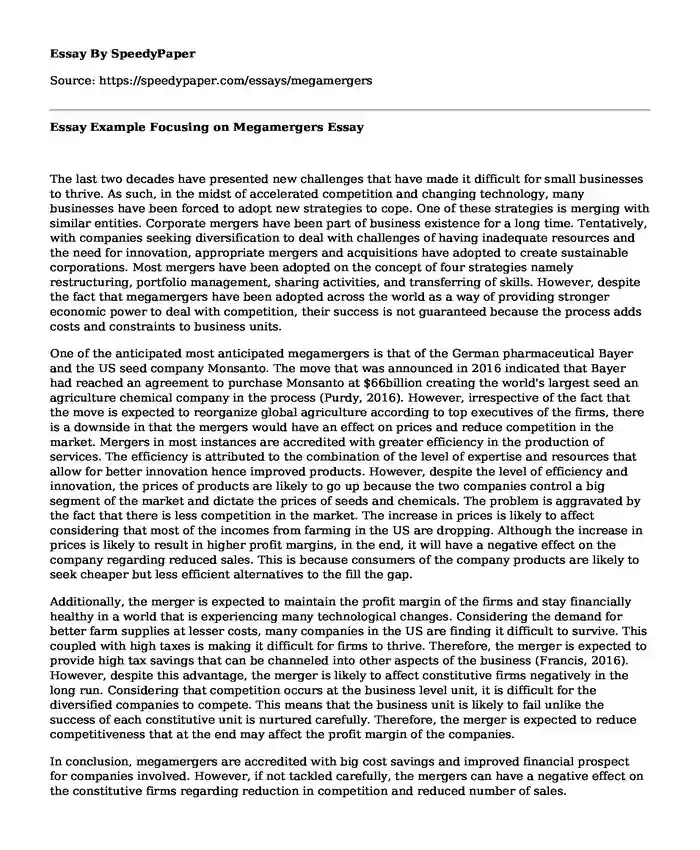
| Type of paper: | Course work |
| Categories: | Business strategy |
| Pages: | 3 |
| Wordcount: | 643 words |
The last two decades have presented new challenges that have made it difficult for small businesses to thrive. As such, in the midst of accelerated competition and changing technology, many businesses have been forced to adopt new strategies to cope. One of these strategies is merging with similar entities. Corporate mergers have been part of business existence for a long time. Tentatively, with companies seeking diversification to deal with challenges of having inadequate resources and the need for innovation, appropriate mergers and acquisitions have adopted to create sustainable corporations. Most mergers have been adopted on the concept of four strategies namely restructuring, portfolio management, sharing activities, and transferring of skills. However, despite the fact that megamergers have been adopted across the world as a way of providing stronger economic power to deal with competition, their success is not guaranteed because the process adds costs and constraints to business units.
One of the anticipated most anticipated megamergers is that of the German pharmaceutical Bayer and the US seed company Monsanto. The move that was announced in 2016 indicated that Bayer had reached an agreement to purchase Monsanto at $66billion creating the world's largest seed an agriculture chemical company in the process (Purdy, 2016). However, irrespective of the fact that the move is expected to reorganize global agriculture according to top executives of the firms, there is a downside in that the mergers would have an effect on prices and reduce competition in the market. Mergers in most instances are accredited with greater efficiency in the production of services. The efficiency is attributed to the combination of the level of expertise and resources that allow for better innovation hence improved products. However, despite the level of efficiency and innovation, the prices of products are likely to go up because the two companies control a big segment of the market and dictate the prices of seeds and chemicals. The problem is aggravated by the fact that there is less competition in the market. The increase in prices is likely to affect considering that most of the incomes from farming in the US are dropping. Although the increase in prices is likely to result in higher profit margins, in the end, it will have a negative effect on the company regarding reduced sales. This is because consumers of the company products are likely to seek cheaper but less efficient alternatives to the fill the gap.
Additionally, the merger is expected to maintain the profit margin of the firms and stay financially healthy in a world that is experiencing many technological changes. Considering the demand for better farm supplies at lesser costs, many companies in the US are finding it difficult to survive. This coupled with high taxes is making it difficult for firms to thrive. Therefore, the merger is expected to provide high tax savings that can be channeled into other aspects of the business (Francis, 2016). However, despite this advantage, the merger is likely to affect constitutive firms negatively in the long run. Considering that competition occurs at the business level unit, it is difficult for the diversified companies to compete. This means that the business unit is likely to fail unlike the success of each constitutive unit is nurtured carefully. Therefore, the merger is expected to reduce competitiveness that at the end may affect the profit margin of the companies.
In conclusion, megamergers are accredited with big cost savings and improved financial prospect for companies involved. However, if not tackled carefully, the mergers can have a negative effect on the constitutive firms regarding reduction in competition and reduced number of sales.
References
Francis, D. (2016). Is the Bayer Monsanto merger too big to succeed? chicagotribune.com. Available at: http://www.chicagotribune.com/business/ct-bayer-monsanto-merger-20160916-story.html
Purdy, C. (2016). Six companies are about to merge into the biggest farm-business oligopoly in history. Quartz. Available at: https://qz.com/786382/monsanto-bayer-dupont-dow-chemical-and-syngenta-defend-their-coming-oligopoly-mon-dd-dow-syt/
Cite this page
Essay Example Focusing on Megamergers. (2022, Mar 09). Retrieved from https://speedypaper.net/essays/megamergers
Request Removal
If you are the original author of this essay and no longer wish to have it published on the SpeedyPaper website, please click below to request its removal:
- Free Essay on Yahoo Human Resources
- Free Essay Sample on Animal Communication
- Free Essay: Webgraph Analysis and Webometrics - Enhancing the Structure of Academic Websites
- Reflection Essay Sample on Business Writing
- Essay Sample: The Conditions in Detention Centers at the United States Border
- Essay Sample. Victor LaValle's book and J. Peele's film Get Out
- Essay Sample: Management in Practice (Positive Behavior in Classroom Management)
Popular categories




